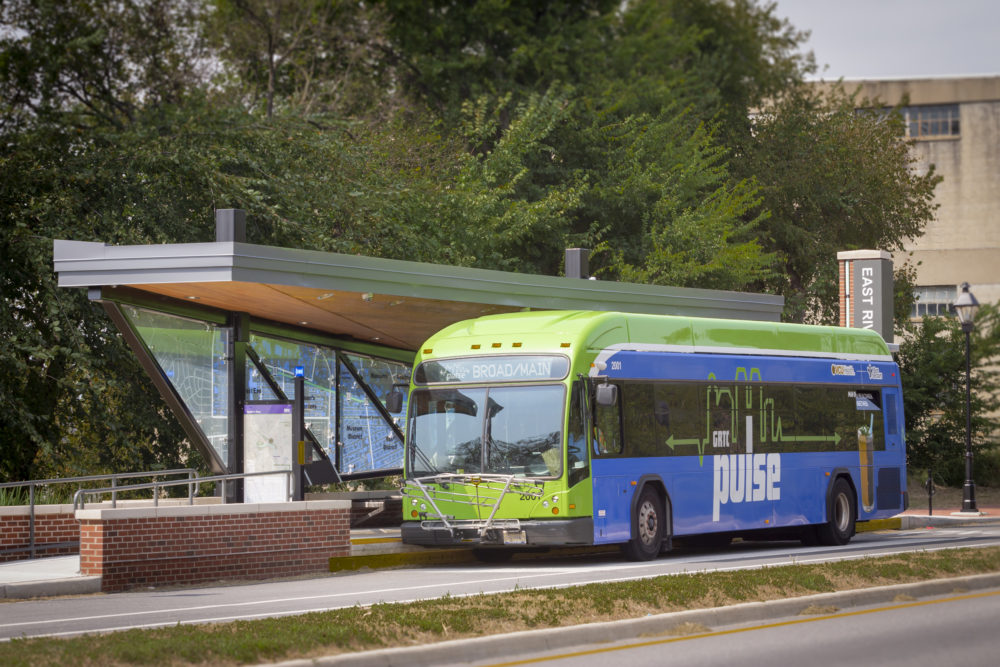Advertisement
A Year Ago, Richmond Debuted A New Bus System. Transit Ridership Is Up 17%
Resume
Richmond, Virginia, has seen at least a 17% bump in transit ridership in the year since it debuted the city's bus rapid transit system, called GRTC Pulse, with average ridership on the new line double what planners initially expected.
At the same time, transit ridership nationally declined by nearly 2%.
So what is Richmond doing right?
Garland Williams, director of planning and scheduling with the Greater Richmond Transit Company, tells Here & Now a total redesign of the city and county's outdated bus system is paying significant dividends.
"That roughly hadn't been done in about 30 years," Williams says.
The Institute for Transportation and Development Policy recently recognized Richmond's Pulse bus as one of the best rapid transit corridors in the country. It boasts features and amenities you might expect to see on a subway or light rail system, but with greater route flexibility — and all at a much cheaper cost.
"It has features that are very different than our local bus system: It has level boarding platforms, off-board fare collections," he says. "What it means is that you don't necessarily pay your fare like you would on a normal bus by getting on and using a fare box. So we have ... ticket vending machines at each one of the stations, you pay there prior to getting on, which actually helps us speed up the movement of our buses."
Interview Highlights
On the benefits of the Pulse system's level boarding, and other offerings
"The level boarding is designed to get you on and off quicker. So we open up both doors when we go docking into one of our our stations, and they're concrete structure, so they're big, they're permanent, they're beautiful. It's all designed to allow you to move in and out safely. But also there are a number of other features on there. It has real-time arrival signage to make your connection between our local system and our Pulse system ... so it's a very nice, convenient way to get around the city."
On passengers sneaking onto buses and not paying their fare
"Yes, unfortunately we do have that problem. And I think it's a national problem. But we are working with our local jurisdictions to try to help alleviate this problem. We're also ... looking at other options. We also have a dedicated security force that we contract, a third party, that goes in and basically goes down the aisle, checks individual passes — sort of like when you board a train and you buy your ticket and the conductor comes by and asks for you to show your ticket."
On cities Richmond looked to for inspiration as it undertook its bus rapid transit project
"We were fortunate enough to look at what we would consider the gold standard when we were looking at our BRT project, [which] was the Cleveland HealthLine system. So Cleveland already had one, Grand Rapids, Michigan [had one]. So we visited those areas but when we did our project — Cleveland's project was almost a couple hundred million dollars. Our system is basically $64 million, it took for construction. So yes, we've studied others, that was on the BRT side, and then we looked at the total redesign, we looked at the [bus system overhaul] that had happened in Houston."
On cities focusing more of their transportation attention on buses, instead of subways or light rail, and striking the right balance
"I would say it's a combination. So yes, I would say you can move people faster, cheaper, with the bus system. if you get it right, people will use it, and we're a testament to that. So if cities are looking at a BRT project, I say the first thing that they need to do is really take a hard look at their current system and how it will complement or enhance the BRT project they're contemplating. So as we're working through our model, we wanted to put the BRT in to be the gold standard. But we also wanted to make sure that individuals are able to easily connect to that system to make it easy for them to move around. So both projects go hand in hand.
"Initially, as the director of planning scheduling, I was totally against doing both projects because it was such a massive amount of work to be done. But in retrospect, it was absolutely the most appropriate thing for us to do. And we are a living testament of that."
On whether there will ever be dedicated bus lanes throughout the system
"Probably not. Unfortunately, that's a huge haul. So what you're really asking folks to do is sacrifice lane miles to allow the buses to have quicker access. So you're squeezing off the ability for folks to just move around in their normal cars. Now, as a guy who loves public transit, I wouldn't be necessarily that mad at them getting on our bus. But we don't think that we could employ dedicated lanes all over the city."
Chris Bentley produced this interview and edited it for broadcast with Todd Mundt. Jack Mitchell adapted it for the web.
This segment aired on July 12, 2019.
